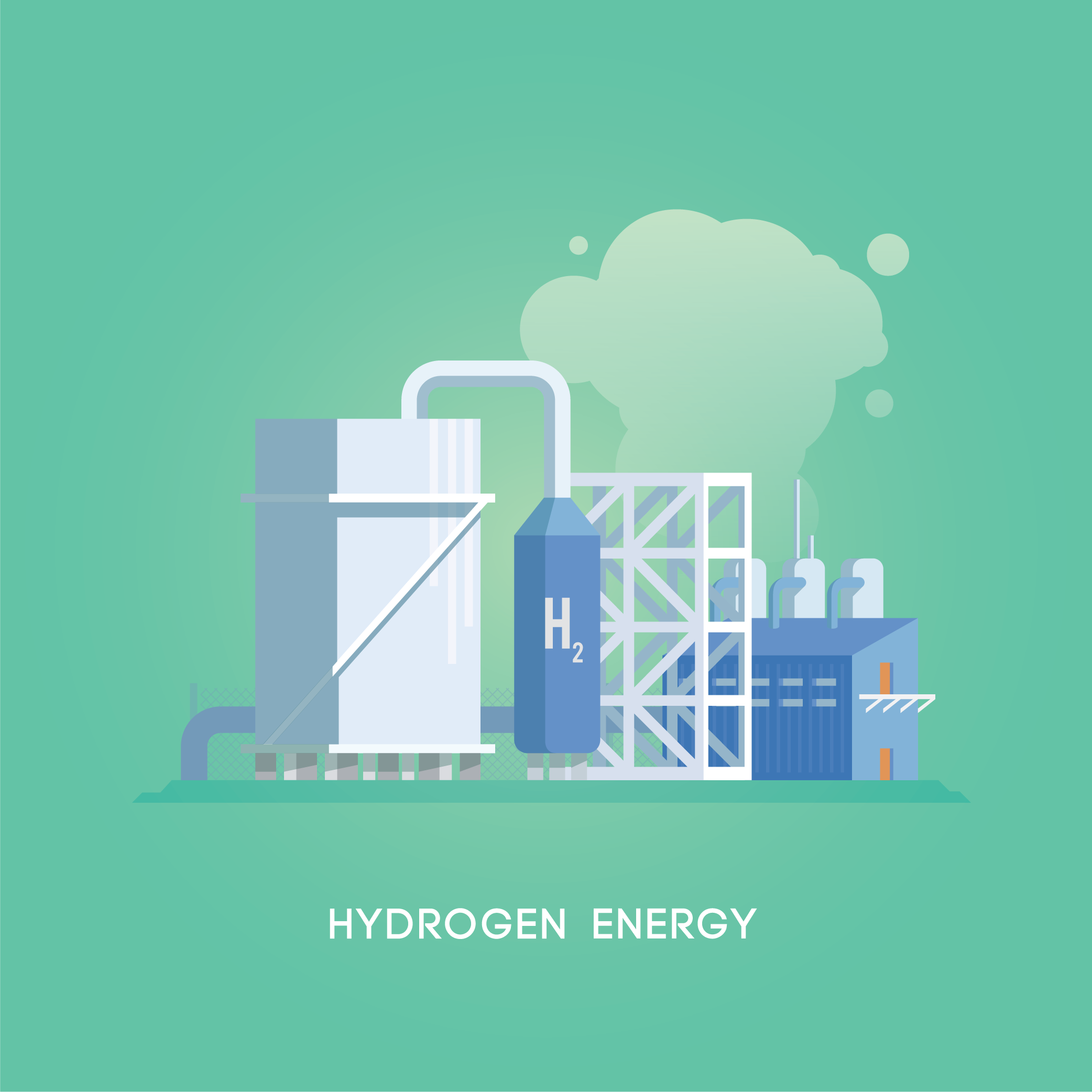Design Implications Associated with the Addition of Hydrogen at Upstream and Midstream Facilities
Posted on March 22nd, 2021
Posted in Newsletter Volume 1 Tags: Hydrogen

Hydrogen is a growing subject matter not just in the oil and gas industry but in the energy conversation. It is a clean fuel that does not contribute to greenhouse gases in the atmosphere when burned / reacted. While there are oil and gas facilities, such as refineries, that are familiar with the design requirements related to hydrogen, it will be unfamiliar to many upstream and midstream operators. If hydrogen is being evaluated as a new fuel source at an oil and gas facility, there are design requirements that must be considered during the project to ensure a safe and successful execution.
Electrical area classifications are assigned to places where a fire or explosion potential may exist, as electrical equipment installed in such locations could provide an ignition source. Area classifications are based on the flammability and auto-ignition temperature of a hazardous material, as well as the likelihood of the hazardous material to be present in a flammable concentration. A majority of upstream and midstream oil and gas facilities are designed for Class 1, Division 2, Groups C and D. The Class 1, Division 2 assignments designate that ignitable concentrations of flammable substances are not likely to exist under normal operating conditions. The group designations are related to the specific chemical properties of the materials present, such as minimum ignition energy and upper and lower explosive limits. Group D includes propane and methane, and Group C includes ethylene. Hydrogen is included in Group B due to its wide flammability range, so the area classification, and thereby design requirements, become more stringent when hydrogen is present.
Vendors use to providing equipment and instrumentation for the typical oil field Class 1, Div 2, Groups C/D area classification can easily overlook the Group B requirement. Oftentimes equipment and / or instrumentation with the additional rating requirements will be more expensive, making it easier to select cheaper, but deficient, units. Lead times for equipment / instrumentation may be similar with a Group B designation, but if selections are made that are not suited to the requirements, this could lead to project delays once the deficiencies are uncovered. In some instances, the operator’s preferred vendors may not be able to provide equipment and/or instrumentation to meet the more stringent area classification.
There may be difficulty in getting instrumentation with the right area classification, necessitating the addition of purge boxes which introduces another opportunity for increased cost and schedule delay. In other cases, vendors may propose “explosion proof” instrumentation to satisfy the requirement, but “explosion proof” does not necessarily mean the units are rated for Group B.
In conclusion, owners and designers should be mindful that the addition of hydrogen introduces complexities in project execution. The increased opportunity for error associated with the addition of hydrogen to an oil and gas facility means that all RFQs and bids must be conditioned especially carefully when selecting equipment and / or instrumentation. Owners should consider if a more nuanced Area Classification Study is warranted, which could add some complexity to the facility but possibly simplify overall project execution if hydrogen won’t be present site-wide. If hydrogen is being added to an existing facility, the operator must also review the existing equipment / instrumentation on site to determine if any modifications are required to meet the requirements of the Group B designation. Operators can expect some increase in cost and possibly lead time with the addition of hydrogen.
 Curtis Anderson is a seasoned Projects Director at Halker, specializing in managing projects for electric utilities and renewable energy companies, including high voltage power, solar, wind, and battery energy storage systems (BESS). Prior to his current role, Curtis held various leadership positions with 12 years in the industry. As Technology Innovation Manager, he was instrumental in establishing and leading a Product and Innovation team within the Power and Renewables Industry, driving technology enablement initiatives, and fostering a culture of innovation. His work included guiding the development of new products, implementing AI-driven solutions, and supporting the launch of industry-first SaaS offerings. Curtis also played a key role in business-to-business collaborations, strategic planning, and served as a member of an Artificial Intelligence Governance Board, focusing on enhancing operational efficiency through technology and R&D efforts.
Curtis Anderson is a seasoned Projects Director at Halker, specializing in managing projects for electric utilities and renewable energy companies, including high voltage power, solar, wind, and battery energy storage systems (BESS). Prior to his current role, Curtis held various leadership positions with 12 years in the industry. As Technology Innovation Manager, he was instrumental in establishing and leading a Product and Innovation team within the Power and Renewables Industry, driving technology enablement initiatives, and fostering a culture of innovation. His work included guiding the development of new products, implementing AI-driven solutions, and supporting the launch of industry-first SaaS offerings. Curtis also played a key role in business-to-business collaborations, strategic planning, and served as a member of an Artificial Intelligence Governance Board, focusing on enhancing operational efficiency through technology and R&D efforts. Shannon McKibben is the director of Environmental Engineering at Halker, executing environmental, health, and safety projects for clients in construction, oil & gas, transportation, and power delivery. Under Shannon’s leadership, Halker’s Environmental Engineering group is actively diversifying from its historical role serving primarily road and highway construction clients into a support group for all of Halker’s projects, focusing on energy delivery and development.
Shannon McKibben is the director of Environmental Engineering at Halker, executing environmental, health, and safety projects for clients in construction, oil & gas, transportation, and power delivery. Under Shannon’s leadership, Halker’s Environmental Engineering group is actively diversifying from its historical role serving primarily road and highway construction clients into a support group for all of Halker’s projects, focusing on energy delivery and development. Dominic brings over 15 years of leadership in privately held and PE‑backed firms. Dominic’s experience in the energy industry expands across several sectors, including refining, midstream & pipeline and delivering fully modular facility solutions in the upstream production arena. Dominic has been involved in the sales and project management of more than 30 fully modular facilities in the Permian basin. He has built scalable go‑to‑market strategies that have helped drive impressive revenue growth: from $10M to $25M at Welker, and launching Petrosmith’s Modflex line to $40M in three years, while more than doubling revenue with its largest client.
Dominic brings over 15 years of leadership in privately held and PE‑backed firms. Dominic’s experience in the energy industry expands across several sectors, including refining, midstream & pipeline and delivering fully modular facility solutions in the upstream production arena. Dominic has been involved in the sales and project management of more than 30 fully modular facilities in the Permian basin. He has built scalable go‑to‑market strategies that have helped drive impressive revenue growth: from $10M to $25M at Welker, and launching Petrosmith’s Modflex line to $40M in three years, while more than doubling revenue with its largest client. 




 Philip Barr joined Halker in April 2023. With nearly 20 years of structural engineering experience, he has contributed to projects across the oil and gas, pharmaceutical, chemical, mining and metals, and manufacturing industries. Philip has successfully led structural design teams in executing projects totaling over one billion dollars in value. He has also worked internationally as a field engineer and client representative, gaining valuable experience in constructability, modular design, and retrofit construction. As Halker’s Director of Structural Engineering, Philip draws on his extensive background and technical expertise to deliver innovative and cost-effective structural solutions for clients across a wide range of industries.
Philip Barr joined Halker in April 2023. With nearly 20 years of structural engineering experience, he has contributed to projects across the oil and gas, pharmaceutical, chemical, mining and metals, and manufacturing industries. Philip has successfully led structural design teams in executing projects totaling over one billion dollars in value. He has also worked internationally as a field engineer and client representative, gaining valuable experience in constructability, modular design, and retrofit construction. As Halker’s Director of Structural Engineering, Philip draws on his extensive background and technical expertise to deliver innovative and cost-effective structural solutions for clients across a wide range of industries.
 Cory Shattuck is the Vice President of Power Services at Halker, based in Centennial, Colorado. With a career spanning roles such as Director of Power Delivery, Utility-scale Solar Technical Manager, Substation Technical Manager, and various engineering positions, Cory brings a wealth of experience to the energy sector. Cory’s expertise includes substation design, medium-voltage underground collection systems, electrical studies, and relay settings. In his current role, he leads the Power Services division, overseeing project execution, technical excellence, and strategic growth. His leadership is grounded in a commitment to quality, safety, and innovation in power delivery solutions. He has served as a Quality Manager for a key client and contributed to both Quality and Safety Committees. Cory holds a Bachelor of Science in Electrical Engineering from the South Dakota School of Mines and a Master of Business Administration from Colorado State University. He is also a licensed Professional Engineer.
Cory Shattuck is the Vice President of Power Services at Halker, based in Centennial, Colorado. With a career spanning roles such as Director of Power Delivery, Utility-scale Solar Technical Manager, Substation Technical Manager, and various engineering positions, Cory brings a wealth of experience to the energy sector. Cory’s expertise includes substation design, medium-voltage underground collection systems, electrical studies, and relay settings. In his current role, he leads the Power Services division, overseeing project execution, technical excellence, and strategic growth. His leadership is grounded in a commitment to quality, safety, and innovation in power delivery solutions. He has served as a Quality Manager for a key client and contributed to both Quality and Safety Committees. Cory holds a Bachelor of Science in Electrical Engineering from the South Dakota School of Mines and a Master of Business Administration from Colorado State University. He is also a licensed Professional Engineer.



